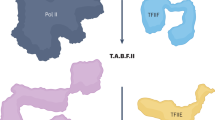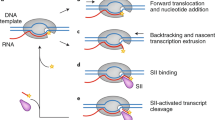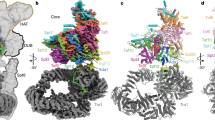Abstract
Activation of gene transcription in metazoans is a multistep process that is triggered by factors that recognize transcriptional enhancer sites in DNA. These factors work with co-activators todirect transcriptional initiation by the RNA polymerase II apparatus1. One class of co-activator, the TAFII subunits of transcription factor TFIID, can serve as targets of activators and as proteins that recognize core promoter sequences necessary fortranscription initiation2,3,4,5. Transcriptional activation by enhancer-binding factors such as Sp1 (ref. 6) requires TFIID, but the identity of other necessary cofactors has remained unknown. Here we describe a new human factor, CRSP, that is required together with the TAFIIs for transcriptional activation by Sp1. Purification of CRSP identifies a complex of approximate relative molecular mass 700,000 (Mr ∼700K) that contains nine subunits with Mr values ranging from 33K to 200K. Cloning of genes encoding CRSP subunits reveals that CRSP33 is a homologue of the yeast mediator subunit Med7 (ref. 7), whereas CRSP150 contains a domain conserved in yeast mediator subunit Rgr1 (ref. 8). CRSP p200 is identical to the nuclear hormone-receptor co-activator subunit TRIP2/PBP9,10. CRSPs 34, 77 and 130 are new proteins, but the amino terminus of CRSP70 is homologous to elongation factor TFIIS11. Immunodepletion studies confirm that these subunits have an essential cofactor function. The presence of common subunits in distinct cofactor complexes suggests a combinatorial mechanism of co-activator assembly during transcriptional activation.
This is a preview of subscription content, access via your institution
Access options
Subscribe to this journal
Receive 51 print issues and online access
$199.00 per year
only $3.90 per issue
Buy this article
- Purchase on Springer Link
- Instant access to full article PDF
Prices may be subject to local taxes which are calculated during checkout




Similar content being viewed by others
References
Tjian, R. & Maniatis, T. Transcriptional activation: a complex puzzle with few easy pieces. Cell 77, 5– 8 (1994).
Pugh, B. F. & Tjian, R. Mechanism of transcriptional activation by Sp1: evidence for coactivators. Cell 61, 1187–1197 (1990).
Dynlacht, B. D., Hoey, T. & Tjian, R. Isolation of coactivators associated with the TATA-binding protein that mediate transcriptional activation. Cell 66, 563 –576 (1991).
Hoey, T. et al. Molecular cloning and functional analysis of Drosophila TAF110 reveal properties expected of coactivators. Cell 72, 247–260 (1993).
Mengus, G. et al. Cloning and characterization of hTAFII18, hTAFII20 and hTAFII28: three subunits of the human transcription factor TFIID. EMBO J. 14, 1520–1531 ( 1995).
Kadonaga, J. T., Carner, K. R., Masiarz, F. R. & Tjian, R. Isolation of cDNA encoding transcription factor Sp1 and functional analysis of the DNA binding domain. Cell 51, 1079 –1090 (1987).
Myers, L. C. et al. The Med proteins of yeast and their function through the RNA polymerase II carboxy-terminal domain. Genes Dev. 12 , 45–54 (1998).
Li, Y. et al. Yeast global transcriptional regulators Sin4 and Rgr1 are components of mediator complex/RNA polymerase II holoenzyme. Proc. Natl Acad. Sci. USA 92, 10864–10868 (1995).
Lee, J. W., Choi, H. S., Gyuris, J., Brent, R. & Moore, D. D. Two classes of proteins dependent on either the presence or absence of thyroid hormone for interaction with the thyroid hormone receptor. Mol. Endocrinol. 9, 243– 254 (1995).
Zhu, Y., Qi, C., Jain, S., Rao, M. S. & Reddy, J. K. Isolation and characterization of PBP, a protein that interacts with peroxisome proliferator-activated receptor. J. Biol. Chem. 272, 25500–25506 ( 1997).
Sekimizu, K., Kobayashi, N., Mizuno, D. & Natori, S. Purification of a factor from Ehrlich ascites tumor cells specifically stimulating RNA polymerase II. Biochemistry 15, 5064 –5070 (1976).
Meisterernst, M., Roy, A. L., Lieu, H. M. & Roeder, R. G. Activation of class II gene transcription by regulatory factors is potentiated by a novel activity. Cell 66, 981– 993 (1991).
Ge, H. & Roeder, R. G. Purification, cloning, and characterization of a human coactivator, PC4, that mediates transcriptional activation of class II genes. Cell 78, 513– 523 (1994).
Kretzschmar, M., Stelzer, G., Roeder, R. G. & Meisterernst, M. RNA polymerase II cofactor PC2 facilitates activation of transcription by GAL4-AH in vitro. Mol. Cell. Biol. 14, 3927–3937 (1994).
Brandsen, J. et al. C-terminal domain of transcription cofactor PC4 reveals dimeric ssDNA binding site. Nature Struct. Biol. 4, 900–903 (1997).
Kim, Y. J., Björklund, S., Li, Y., Sayre, M. H. & Kornberg, R. D. Amultiprotein mediator of transcriptional activation and its interaction with the C-terminal repeat domain of RNA polymerase II. Cell 77, 599–608 (1994).
Yoshikawa, H., Fujiyama, A., Nakai, K., Inazawa, J. & Matsubara, K. Detection and isolation of a novel human gene located on Xp11.2-p11.4 that escapes X-inactivation using a two-dimensional DNA mapping method. Genomics 49, 237– 246 (1998).
Jiang, Y. et al. Mammalian mediator of transcriptional regulation and its possible role as an end-point of signal transduction pathways. Proc. Natl Acad. Sci. USA 95, 8538–8543 (1998).
Sun, X. et al. NAT, a human complex containing Srb polypeptides that functions as a negative regulator of activated transcription. Mol. Cell 2, 213–222 (1998).
Drané, P., Barel, M., Balbo, M. & Frade, R. Identification of RB18A, a 205 kDa new p53 regulatory protein which shares antigenic and functional properties with p53. Oncogene 15, 3013–3024 (1997).
Rachez, C. et al. Anovel protein complex that interacts with the vitamin D3 receptor in a ligand-dependent manner and enhances VDR transactivation in a cell-free system. Genes Dev. 12, 1787– 1800 (1998).
Yuan, C. X., Ito, M., Fondell, J. D., Fu, Z. Y. & Roeder, R. G. The TRAP220 component of a thyroid hormone receptor-associated protein (TRAP) coactivator complex interacts directly with nuclear receptors in a ligand-dependent fashion. Proc. Natl Acad. Sci. USA 95, 7939–7944 (1998).
LeRoy, G., Drapkin, R., Weis, L. & Reinberg, D. Immunoaffinity purification of the human multisubunit transcription factor IIH. J. Biol. Chem. 273, 7134–7140 (1998).
Struhl, K. & Moqtaderi, Z. The TAFs in the HAT. Cell 94, 1–4 ( 1998).
Chrivia, J. C. et al. Phosphorylated CREB binds specifically to the nuclear protein CBP. Nature 365, 855–859 (1993).
Oñate, S. A., Tsai, S. Y., Tsai, M. J. & O'Malley, B. W. Sequence and characterization of a coactivator for the steroid hormone receptor superfamily. Science 270, 1354–1357 (1995).
Kaiser, K. & Meisterernst, M. The human general cofactors. Trends Biochem. Sci. 21, 342– 345 (1996).
Dignam, J. D., Martin, P. L., Shastry, B. S. & Roeder, R. G. Eukaryotic gene transcription with purified components. Methods Enzymol. 101, 582–598 ( 1983).
Yokomori, K. et al. Drosophila TFIIA directs cooperative DNA binding with TBP and mediates transcriptional activation. Genes Dev. 8, 2313–2323 (1994).
Näär, A. M. et al. Chromatin, TAFs and a novel multiprotein coactivator are required for synergistic activation by Sp1 and SREBP in vitro. Genes Dev. 12, 3020–3031 ( 1998).
Acknowledgements
We thank R. Bell for the preparation of HeLa cell nuclei, M. Haggart for DNA sequencing and DNA oligonucleotide synthesis; H. Yoshikawa for plasmids containing the EXLM1 gene; A. Näär, P. Beaurang, C. Inouye and B. D. Lemon for the components of the highly purified transcription system; D. Reinberg for the gift of TFIIH antibody; and D. Rio, Q. Zhou, K. Collins, M. Holmes, R.Freiman, M. D. Rabenstein and B. D. Lemon for comments on the manuscript. S.R. is a Howard Hughes Medical Institute predoctoral fellow and A.G.L. is a Wellcome Trust International Prize Travelling Research Fellow. This work is supported in part by a grant from the NIH to R.T.
Author information
Authors and Affiliations
Supplementary information
Rights and permissions
About this article
Cite this article
Ryu, S., Zhou, S., Ladurner, A. et al. The transcriptional cofactor complex CRSP is required for activity of the enhancer-binding protein Sp1. Nature 397, 446–450 (1999). https://doi.org/10.1038/17141
Received:
Accepted:
Issue Date:
DOI: https://doi.org/10.1038/17141
This article is cited by
-
CRSP8 promotes thyroid cancer progression by antagonizing IKKα-induced cell differentiation
Cell Death & Differentiation (2021)
-
Mediator complex (MED) 7: a biomarker associated with good prognosis in invasive breast cancer, especially ER+ luminal subtypes
British Journal of Cancer (2018)
-
Bilaterian-like promoters in the highly compact Amphimedon queenslandica genome
Scientific Reports (2016)
-
Study of Interactions between DNA and Tetrapeptides Study of Interactions between DNA and Tetrapeptides
Bulletin of Experimental Biology and Medicine (2014)
-
Anti-leukemic response of a NSAID, tolfenamic acid
Targeted Oncology (2014)
Comments
By submitting a comment you agree to abide by our Terms and Community Guidelines. If you find something abusive or that does not comply with our terms or guidelines please flag it as inappropriate.



